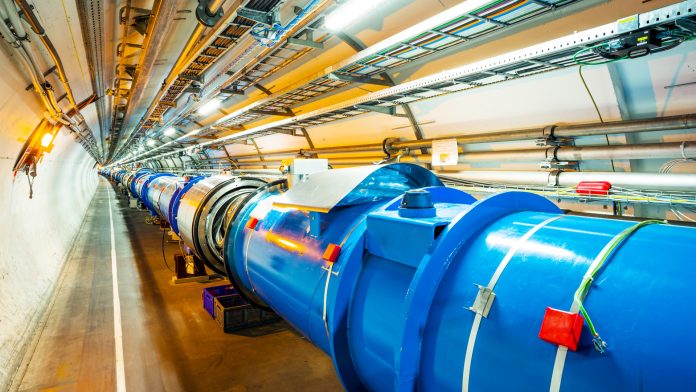With the help of the LHCb at CERN, researchers have detected a new exotic hadron that comprises two charm quarks and an up and down antiquark.
Today (29 July 2021), the Large Hadron Collider beauty (LHCb) experiment at CERN is exhibiting a novel discovery of an exotic hadron at the European Physical Society Conference on High Energy Physics (EPS-HEP).
The newly found particle – called Tcc+ – is a tetraquark, which is an exotic hadron comprising two quarks and two antiquarks. It is the longest-lived exotic matter particle to be detected and the first to have both two heavy quarks and two light antiquarks.
A unique exotic hadron
Quarks are the essential components from which matter is built. They merge to construct hadrons, specifically baryons, like the proton and the neutron, which consist of three quarks, and mesons, which are developed as quark-antiquark pairs.
In more recent years, various exotic hadrons – particles containing four or five quarks as opposed to the typical two or three – have been discovered. This most recent finding is an especially unique exotic hadron as it comprises two charm quarks and an up and a down antiquark.
Novel quark content
This exciting new particle has two charm quarks and an up and a down antiquark. Over the last few years, a few tetraquarks have been detected (including one with two charm quarks and two charm antiquarks), but this is the first with two charm quarks, without charm antiquarks to balance them.
This phenomenon is referred to as an ‘open charm’, or in this case, a ‘double open charm’. Particles comprising of a charm quark and a charm antiquark also have a ‘hidden charm’ – the charm quantum number for the entire particle adds up to zero, much like a positive and a negative electrical charge. Whereas, for this new discovery, the charm quantum number adds up to two.
As well as being an open charm, the quark content of the novel Tcc+ has various other exciting characteristics. It is the first particle to be discovered that belongs to a class of tetraquarks with two heavy quarks and two light antiquarks. These unique particles decay by converting into a pair of mesons, each composed of one of the heavy quarks and one of the light antiquarks.
As understood by theoretical models, the mass of this type of tetraquark should be very close to the sum of masses of the two mesons. This close proximity means that decay is very challenging, leading to a much longer lifetime of the particle, and therefore, Tcc+ is the longest-lived exotic hadron discovered so far.
This revelation opens the doors to the pursuit of heavier particles of the same variety. The particle with two bottom quarks is particularly fascinating, because conforming to calculations, its mass should be lesser than the sum of the masses of any pair of B mesons. This would mean that decay is actually not possible, as the particle would not be able to decay through the strong interaction and would, in theory, have to do so before the weak interaction, making its lifetime several orders of magnitude longer than any formerly studied exotic hadron.
The newly discovered Tcc+ tetraquark is a very appealing prospect for future study. The particles that it decays into are all relatively straightforward to identify and, when combined with the tiny quantity of the obtainable energy in the decay, this results in exceptional accuracy on its mass and enables the study of the quantum numbers of this intriguing particle. Therefore, this can offer a rigorous test for current theoretical models and may possibly enable formerly inaccessible effects to be investigated.









